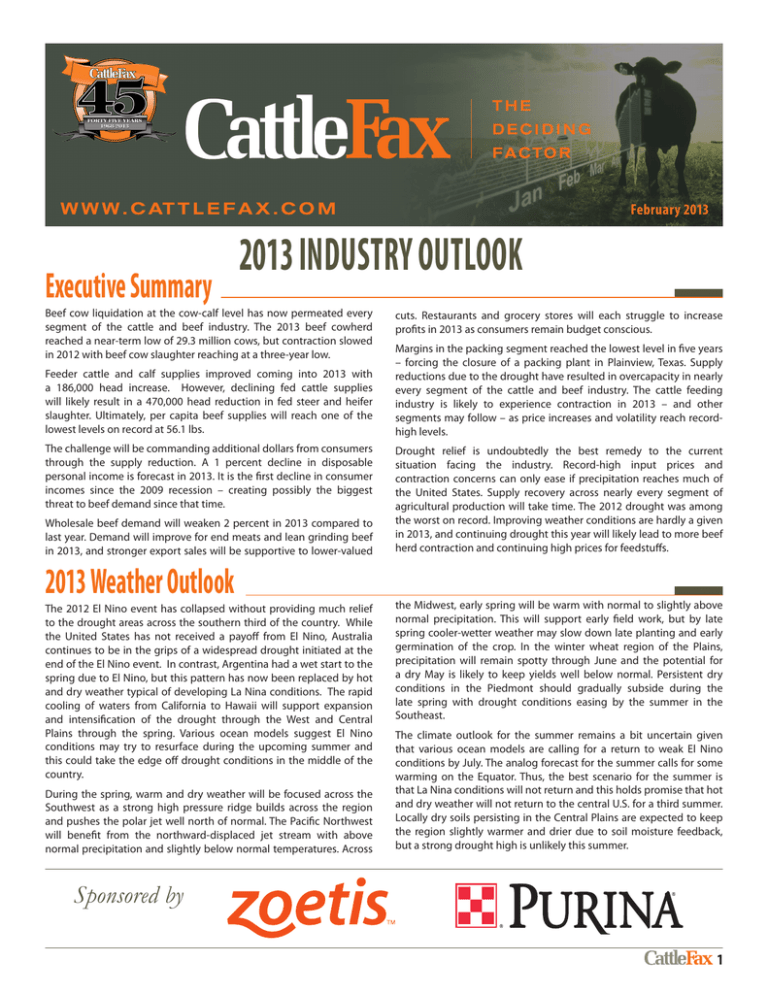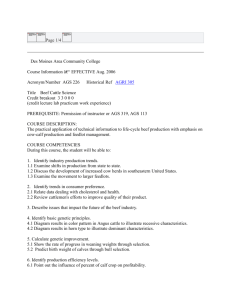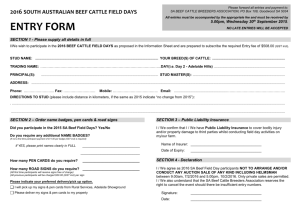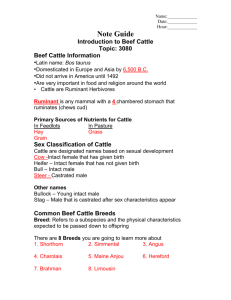
February 2013
Executive Summary
2013 INDUSTRY OUTLOOK
Beef cow liquidation at the cow-calf level has now permeated every
segment of the cattle and beef industry. The 2013 beef cowherd
reached a near-term low of 29.3 million cows, but contraction slowed
in 2012 with beef cow slaughter reaching at a three-year low.
Feeder cattle and calf supplies improved coming into 2013 with
a 186,000 head increase. However, declining fed cattle supplies
will likely result in a 470,000 head reduction in fed steer and heifer
slaughter. Ultimately, per capita beef supplies will reach one of the
lowest levels on record at 56.1 lbs.
The challenge will be commanding additional dollars from consumers
through the supply reduction. A 1 percent decline in disposable
personal income is forecast in 2013. It is the first decline in consumer
incomes since the 2009 recession – creating possibly the biggest
threat to beef demand since that time.
Wholesale beef demand will weaken 2 percent in 2013 compared to
last year. Demand will improve for end meats and lean grinding beef
in 2013, and stronger export sales will be supportive to lower-valued
2013 Weather Outlook
The 2012 El Nino event has collapsed without providing much relief
to the drought areas across the southern third of the country. While
the United States has not received a payoff from El Nino, Australia
continues to be in the grips of a widespread drought initiated at the
end of the El Nino event. In contrast, Argentina had a wet start to the
spring due to El Nino, but this pattern has now been replaced by hot
and dry weather typical of developing La Nina conditions. The rapid
cooling of waters from California to Hawaii will support expansion
and intensification of the drought through the West and Central
Plains through the spring. Various ocean models suggest El Nino
conditions may try to resurface during the upcoming summer and
this could take the edge off drought conditions in the middle of the
country.
During the spring, warm and dry weather will be focused across the
Southwest as a strong high pressure ridge builds across the region
and pushes the polar jet well north of normal. The Pacific Northwest
will benefit from the northward-displaced jet stream with above
normal precipitation and slightly below normal temperatures. Across
cuts. Restaurants and grocery stores will each struggle to increase
profits in 2013 as consumers remain budget conscious.
Margins in the packing segment reached the lowest level in five years
– forcing the closure of a packing plant in Plainview, Texas. Supply
reductions due to the drought have resulted in overcapacity in nearly
every segment of the cattle and beef industry. The cattle feeding
industry is likely to experience contraction in 2013 – and other
segments may follow – as price increases and volatility reach recordhigh levels.
Drought relief is undoubtedly the best remedy to the current
situation facing the industry. Record-high input prices and
contraction concerns can only ease if precipitation reaches much of
the United States. Supply recovery across nearly every segment of
agricultural production will take time. The 2012 drought was among
the worst on record. Improving weather conditions are hardly a given
in 2013, and continuing drought this year will likely lead to more beef
herd contraction and continuing high prices for feedstuffs.
the Midwest, early spring will be warm with normal to slightly above
normal precipitation. This will support early field work, but by late
spring cooler-wetter weather may slow down late planting and early
germination of the crop. In the winter wheat region of the Plains,
precipitation will remain spotty through June and the potential for
a dry May is likely to keep yields well below normal. Persistent dry
conditions in the Piedmont should gradually subside during the
late spring with drought conditions easing by the summer in the
Southeast.
The climate outlook for the summer remains a bit uncertain given
that various ocean models are calling for a return to weak El Nino
conditions by July. The analog forecast for the summer calls for some
warming on the Equator. Thus, the best scenario for the summer is
that La Nina conditions will not return and this holds promise that hot
and dry weather will not return to the central U.S. for a third summer.
Locally dry soils persisting in the Central Plains are expected to keep
the region slightly warmer and drier due to soil moisture feedback,
but a strong drought high is unlikely this summer.
Sponsored by
1
Grains and Energy
Global Grain Stocks
• Record-high prices have incentivized increased production
around the world.
• Hay stocks on December 1, 2012, reached the lowest level
since 1957 – supporting record-high prices.
• Corn stocks-to-use levels remain historically low in the U.S.
and around the world.
• Expect world soybean stocks-to-use levels to hold near the
10-year average. However, U.S. stocks-to-use levels remain
historically low.
• Expect world wheat stocks-to-use levels to hold near the 10year average in both the U.S. and around the world.
Corn Production and Demand
• U.S. corn stocks-to-use levels for the 2012-2013 marketing
year averaged 5.8 percent from September 2012 through
January 2013 – the lowest average during this period since
the data series began in 1973.
• Stocks-to-use levels are expected to range from 5 to 7
percent through April 2013.
• Demand rationing for U.S. corn exports continues amid more
competitively priced supplies outside of the United States.
• Rationing of corn used for 2ethanol production is expected
to continue.
• Only a moderate decline in corn feed-and-residual usage
is projected for 2012-2013 since early pork and poultry
production cuts have not materialized.
• Corn, wheat and soybean acreage is expected to increase in
2013 as producers maximize acreage with new crop futures
prices at or near record-high levels.
• Corn stocks-to-use levels for the 2013-2014 market year have
the potential to reach 10 to 12 percent.
• Corn prices are expected to remain historically high through
first half 2013.
• Continued rationing coupled with better weather conditions,
and a significant increase in corn production, should
pressure corn prices sharply lower by fall 2013.
Energy and Ethanol
• Reduced profitability continues to support sharp year-overyear declines in U.S. ethanol production. However, U.S.
refiner net ethanol inputs continue to run near year-ago
levels.
• Blenders will have to utilize ethanol stocks more aggressively
and the U.S. will have to be a net importer of ethanol to
meet the Renewable Fuels Standard mandated usage. Or
the incentive for blenders to utilize ethanol will have to be
displaced by the use of Renewable Identification Number
(RIN) credits instead of physical ethanol.
• U.S. gasoline prices are likely to trade in a seasonal manner
with a peak in the spring.
• Fuel demand remains soft, and prices should struggle to
trade much higher than year-ago levels.
2
Global Beef Trade
Global Protein Supply and Demand
• Total global beef, pork and poultry production will expand
0.7 percent in 2013, compared to a more aggressive five-year
average growth rate at 1.9 percent.
• Per-capita global beef supplies will decline 0.4 percent. • India water-buffalo growth is outpacing all other beef
growth. However, this product is much cheaper than U.S.
beef and is destined to countries in that region. It is not a
global competitor to U.S. beef.
• Beef supplies – excluding India’s production – will decline
2 lbs. per capita on a global basis – the sixth-consecutive
annual decline.
• Expect global beef prices to move higher. In the last 5 years,
a beef production decline of nearly 6 bil. lbs. occurred as the
global economy grew $4.1 tril.
• U.S. beef production will be down 4 percent, and EU
production will be down 1 percent in 2013. Slight growth
is possible in Brazil and Argentina, and Australia will see 2
percent growth but remains a smaller production center at
about 20 percent of U.S. beef production.
• The EU ban on sow gestation stalls will lead to production
declines in Europe and support global pork and beef prices.
• U.S. pork exports will be 2 percent higher in 2013 as
stronger demand in Mexico, Japan and Canada offsets the
export losses from Russia’s ban on U.S. pork produced with
ractopamine. U.S. broiler exports should increase 3 percent
due mostly to continued growth in Mexico.
U.S. Beef Exports
• Higher U.S. grinding beef prices in 2013 will continue to
support prices for end and thin meats – pricing beef exports
higher.
• Mexico – the No. 1 market for U.S. beef prior to 2010 – fell
to No. 3 in 2012 as higher round prices discouraged export
sales. This trend will continue in 2013.
• Beef exports will increase in 2013 due to newly-expanded
access to Japan. Expect total beef exports to increase 3
percent in 2013. Exports to Japan will improve 27 percent.
• Expect U.S. hide and offal values to increase by $1/cwt.
in 2013 on Japan access alone. Beef tongues command a
strong premium in Japan. The average U.S. tongue price was
$2.40/lb. in 2012, but Japan wholesale values are currently
near $5/lb.
U.S. Beef Imports
• U.S. beef imports continue to increase due stronger demand
for lean grinding beef. Australian beef production will be
near-record high allowing ample 2013 exportable supplies.
• A U.S. cow slaughter decline of roughly 600,000 head is
forecasted in 2013, further stimulating import demand.
Cattle Imports
• U.S. cattle imports have trended higher from Mexico and
lower from Canada in recent years.
• U.S. feeder cattle imports from Mexico reached a record
1.45 mil. head in 2012 due to weather and market prices.
Precipitation and prices will be a factor again in 2013 but
aggressive 2012 imports should reduce available supplies.
3
Cattle Numbers and
Meat Production
Cattle Numbers and Slaughter
• Total cattle numbers have declined more than 7 mil. head
in the past six years and are now below 90 mil. head for the
first time since the early 1950s.
• The U.S. beef cowherd continued to liquidate in 2012, but it
was the smallest beef cow slaughter in the last three years.
The 2013 beef cowherd declined 860,000 head – reaching
29.3 mil. cows.
• Improving moisture conditions in 2013 could begin to
stabilize the beef cowherd by 2014.
• Expect total cow slaughter to decline by 600,000 head in
2013 as more producers retain heifers – assuming improved
precipitation.
• A declining calf crop is expected to reduce 2013 fed
slaughter by 470,000 head – totaling 25.4 mil. head.
• Heifer slaughter as a percentage of 2012 fed slaughter
was down – indicating producers are attempting to keep
replacement heifers.
• Dairy cow numbers are mostly steady for 2013 – down
about 10,000 head (-0.1 percent) as dairy cow slaughter was
up 6 percent in 2012. Expect little to no growth in the dairy
herd in 2013.
Feeder Cattle and Calf Supplies
• Feeder cattle and calf supplies outside of feedyards on
January 1 were up 0.7 percent – an increase of about
186,000 head.
• A smaller 2012 calf crop was offset by an even bigger
decline in cattle on feed explaining the bigger supply
outside of feedlots. Expect a 2013 calf crop that is at least
500,000 smaller.
• Over the last two years, the total feeder and calf supply
outside of feedlots and cattle on feed has declined 2 million
head.
Production and Net Beef Supplies
• Beef production in 2012 was down almost 300 mil. lbs.
compared to a year ago due to smaller fed slaughter. Expect
a 2 percent reduction – or 600 mil. lbs. – in 2013 due to
reduced total cattle slaughter.
• The 2013 carcass weight forecast for 2013 is 8 lbs. higher in
2013 due to a mild winter and beta agonist usage.
• Per capita net beef supplies were nearly flat in 2012 at 57.4
lbs. Per capita supplies will decline in 2013 to 56.1 lbs.
Pork and Poultry
• Pork production was up 2 percent in 2012. For 2013, pork
production is forecast near even with 2012 as tight profit
margins inhibit expansion, while production efficiency
increases.
• Broiler production is forecast to increase about 1 percent in
2013 due to improving demand and strong exports. Broiler
production was down 1 percent in 2012.
4
Beef Demand and Economics
Protein Segment Outlook
• The forecast for domestic beef demand is weaker in 2013, due
mostly to expected weakness in consumer incomes and U.S.
economic performance.
• Beef will struggle to remain price competitive relative to pork
and chicken, even as prices for competing proteins increase.
• Per capita pork supplies will be down 2 percent in 2013 at
44.8 lbs., and increasing wholesale demand will lead to a 5
percent increase in wholesale values.
• Expect per capita broiler supplies to be down 0.6 percent
at 80.1 lbs. Higher feed prices are not deterring poultry
production and a 3 percent increase in exports is expected.
• Expect higher pork and broiler prices to support production
increases from late 2013 to 2014 – providing corn prices
decline.
Wholesale Market Factors
• Expect wholesale beef demand to decline 2 points in 2013 –
reaching 112 percent of 1998 levels.
• Export sales and a fragile domestic market should support
prices for end-meat cuts in 2013. A higher 90 percent lean
trimmings market could also support end and thin meats as
processors explore alternatives for competitively priced lean
trim.
• Weaker middle meat demand is possible in 2013, but rib and
loin values should reach new highs in the spring and fall to
ration a tighter supply of Choice carcasses.
• Expect the Choice-Select spread to increase $2 in 2013 –
averaging $12/cwt. Tighter Choice supplies will lead to a
wider peaks in the spread.
Retail and Foodservice Trends
• Expect retail beef prices at $4.85/lb. in 2013 – improving
around $0.12 from 2012.
• Retailers will struggle to feature beef in advertisements at
higher prices. Expect a 4 percent drop in beef advertising.
• Restaurant sales growth will be limited in 2013. A fragile
domestic economy and lagging consumer incomes will limit
expansion.
• Most consumers will visit fast-casual restaurants over finedining establishments due to the higher perceived value
offered.
Economic Outlook
• Government policy will influence incomes considerably in
2013. Based on current figures, U.S. incomes and GDP have
the potential to decline by as much as 3 percent.
• Higher beef prices will ration smaller supplies, but sustained
price increases in the 2013 cattle and beef market depend on
consumers’ willingness to pay higher prices.
• The fiscal cliff concerns have subsided, but elected officials
still need to balance concerns surrounding tax cuts,
government spending and debt ceiling levels.
• An improving domestic economy seems unlikely, but
emerging global markets will continue to bid aggressively for
U.S. beef in 2013.
5
Price Outlook
All Fresh Retail – Expected Avg. = $4.85/lb., +4%
• Tough economic conditions and competition from other
proteins will limit price increases and retail-featuring activity,
but record-high prices are expected to continue.
Composite Cutout – Expected Avg. = $196/cwt., +4%
• Smaller domestic beef production, more exports and price
increases from competing proteins will support prices.
Expect wholesale demand to be 2 percent weaker. Tighter
Choice supplies will be more price supportive to the ChoiceSelect spread than demand.
Fed Cattle – Expected Avg. = $126/cwt., +2.4%
• Declining fed cattle numbers and stronger exports should
increase fed cattle prices for the fourth-consecutive year. Fed
cattle prices have increased 50 percent since 2009. A price
increase of that magnitude has not been seen since 1981.
Expect annual lows near $116/cwt. and a high around $134 in
the fourth quarter.
750-lb. Steers – Expected Avg. = $155/cwt., +5.8%
• Tighter supplies, excess feeding capacity and premiums in
deferred live cattle futures will support higher values. Prices
are expected to be volatile with corn and futures fluctuations
and could easily range from the low $140s to the mid $160s.
Continued drought has the potential to limit sustainable
profits.
550lb Steer – Expected Avg. = $175/cwt., +4.5%
• Cow-calf producers will continue to maintain leverage as
other segments look for additional supplies. Record-high
feeder and fed cattle prices will likely support higher calf
prices in 2013. Profitability may depend on drought relief,
but low-cost producers should maintain favorable margins.
Spring moisture could lead to a significant spring price rally
with calf values exceeding $200/cwt.
Cull Cows – Expected Avg. = $88/cwt., +10%
• Values will be record high again in 2013. Smaller cow
slaughter and strengthening domestic ground beef demand
will influence the cull cow market. Fewer supplies will
especially be true with moisture in the Central Plains leading
to expansion in the cow-calf segment.
Bred Females – Expected Avg. = $1,550/head, +18%
• Record-high calf values will support record-high bred female
prices. Drought conditions and smaller feed supplies have
limited female price increases. Profit incentives remain,
but drought has limited the options for many producers.
Prices will likely not deteriorate from current values. Upside
potential could lead to an annual increase in value up to
$300/head. Corn – Expected Avg. = $6.10/bu., -12%
• U.S. and world corn stocks-to-use levels are expected to
remain historically low in 2013. Higher prices are expected
to ration usage across all categories – especially in first half
2013. Planted acreage is expected to increase, and yield
improvement will come if moisture levels improve.
6
Risk and Strategies Outlook
Industry Structure
• The cattle and beef industries will continue to deal with
the consequences of excess capacity as fed cattle slaughter
declined 1.6 million head from 2008 to 2012. Another
470,000 head decline is expected in 2013.
• Excess capacity in the packing segment reached 15 percent
in 2012 – resulting in the narrowest packer margins since
2007. The closing of the Plainview, Texas, packing facility
on February 1 will allow the packing segment to begin
balancing capacity with a smaller available fed cattle supply.
• Cattle feeders commanded more dollars from the packing
segment over the last 18 months. Fed cattle prices as a
percentage of the boxed beef cutout in 2012 were at a 12year high. In 2013, that percentage is expected to decline 1
percent – equaling a $2/cwt. shift in leverage. • Excess capacity in the cattle feeding segment is estimated
at more than 25 percent. Feedyards in all regions will reduce
capacity due to poor profit margins and the large amount of
capital required to operate.
• Trends continue to favor the increased use of alternative
market arrangements. An estimated 76 percent of fed
cattle traded outside of the negotiated cash market in 2012
compared 51 percent of cattle in 2002. In the wholesale
beef market, 63 percent of sales occurred outside of the
negotiated cash market – compared to 52 percent in 2002.
Cattle Feeding Margins
• Multiple factors suggest cattle feeding margins will be poor
in 2013.
• Record-high fed cattle breakeven prices will challenge
feedyard profitability in 2013. The estimated U.S. average
breakeven for current cattle on feed is between $130 to
$135/cwt. Cattle have only sold at or above $130/cwt. one
week in the history of cattle feeding. Feedyards need at
least that price to be profitable in early 2013.
• Current fed cattle are selling at a price below the breakeven
price for cattle entering feedyards. This is a negative swap.
Replacement cattle purchased at a negative swap in the
first four months of a calendar year have an 80 percent
probability of losing money as summer marketed fed cattle.
• Live cattle futures prices continue to trade significantly
higher than the fed cattle cash market – creating an under
performing market where cash prices never reach the levels
futures imply. Basis is expected to remain weaker than the
historical average in 2013.
Capital/Credit Needs
• Increasing capital requirements and risk without improving
returns will continue to burden the cattle industry. Returns
to cattle feeding have been outpaced by operating
investment and volatility over the last 10 years. Access to
capital and credit for individuals and businesses to operate
successfully will be tested.
• Volatility will lead to more producers developing risk
management plans to secure long-term success. The
variation in fed cattle values within a year increased $75 per
head over the last three years, while fed cattle prices have
increased from an average of $95/cwt. to a forecasted $126
in 2013.
7
Who do you trust
for cattle market information?
Cattle producers and industry leaders have trusted
CattleFax for market data and decision-based analysis for 45 years.
Sign up for a new CattleFax membership during convention and receive a two-year membership at the
single-year rate of $200. Receive the weekly Update and monthly Trends newsletters as well as weekly
market commentary and daily prices.
Sign up during convention at Booth #613,
visit www.CattleFax.com or call 800-825-7525 to become a member.
2013 CattleFax
Seminar Dates
Learn more about risk management strategies,
industry structure, and future price and
trend changes at these CattleFax programs
in Denver:
RISK MANAGEMENT SEMINAR
June 12 and 13
September 25 and 26
CORPORATE COLLEGE
July 24 and 25
2014 OUTLOOK & STRATEGIES
December 3
Market Insight
When You Want It
CattleFax now offers you
market information at
your finger tips.
Sponsored by Zoetis, you
can now have access to
CattleFax market insight
when you want it − 24/7.
Free trial offer
during the month
of February, 2013.
Download the CattleFax
mobile app from iTunes,
GooglePlay or at
www.cattlefax.com.
NOW MOBILE
All trademarks are the property of their respective owners. ©2013 Zoetis Inc.
©2013 Cattle Marketing Services, Inc. All rights reserved. GBF12018
would like to thank its sponsors for making this presentation possible.
Copyright 2013 Cattle Marketing Information Service, Inc. Not to be reproduced in total or in part.
While CattleFax believes that the data/information provided is accurate and complete, no warranty is made with respect thereto. CattleFax shall not be liable for decisions or actions taken by the use based on the data/information.
8







